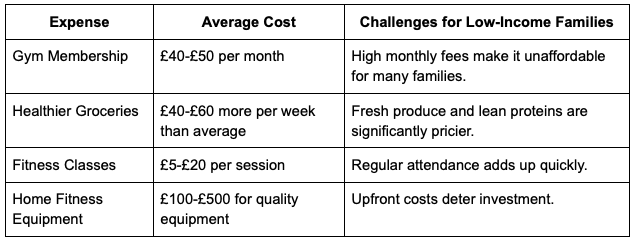The rising concerns over obesity and sedentary lifestyles have pushed the UK government to introduce numerous policies aimed at improving the nation’s health. While the intention behind these policies is commendable, their implementation and affordability remain topics of debate, especially for families on tighter budgets. This article explores the nuances of these policies, their financial implications, and whether they adequately cater to low-income households.
The State of Obesity and Fitness
The UK faces a growing obesity crisis, with nearly 64% of adults classified as overweight or obese, according to recent statistics. This issue extends to children, with around one in three primary school leavers being overweight or obese. The government has taken steps to address this by implementing initiatives such as the Soft Drinks Industry Levy (commonly known as the sugar tax), public awareness campaigns, and funding for local fitness programmes.
While these measures aim to curb obesity rates and promote healthier lifestyles, they often overlook the financial constraints faced by families living paycheck to paycheck. A gym membership, healthier food options, and fitness equipment can quickly add up, leaving low-income households struggling to participate fully in these initiatives.
Key Government Policies on Weight Loss and Fitness
The UK government has introduced various policies to tackle obesity and encourage fitness:
- The Sugar Tax: Introduced in 2018, this levy on sugary drinks incentivises manufacturers to reduce sugar content. Revenue from this tax has been channelled into school sports programmes and health campaigns.
- Calorie Labelling in Restaurants: As of 2022, large businesses are required to display calorie counts on menus to help consumers make informed choices.
- Funding for Active Travel: Programmes promoting cycling and walking, such as Active Travel England, aim to create healthier communities.
- NHS Weight Loss Services: The National Health Service (NHS) offers free weight loss advice, structured programmes, and access to dieticians for those with obesity.
The Cost of Healthy Living for Families
While the policies sound promising on paper, the reality for families, especially those with lower incomes, tells a different story. Here’s a breakdown of some common expenses associated with weight loss and fitness:

For families relying on food banks or government benefits, these costs often mean that healthier lifestyles remain out of reach. Instead, they turn to calorie-dense, cheaper foods that exacerbate health issues.
Challenges in Policy Effectiveness
Several barriers prevent the successful implementation of these policies among lower-income groups:
- Access to Resources: Many low-income families live in areas with fewer parks, sports facilities, or supermarkets offering affordable healthy options.
- Education and Awareness: While calorie labelling is a step forward, not all consumers understand nutritional information or how to use it to improve their diet.
- Economic Pressures: Rising costs of living make prioritising health-related expenses difficult for many households.
Potential Solutions and Improvements
Addressing these barriers requires a multi-faceted approach. Here are some suggestions to improve the reach and effectiveness of government policies:
- Subsidies for Healthy Food: Offering vouchers or discounts for fresh produce and healthier foods could encourage better eating habits.
- Community Fitness Programmes: Free or subsidised fitness classes in community centres could make exercise more accessible.
- Improved Access to Green Spaces: Investing in safe parks and walking paths in low-income areas can promote physical activity.
- Education Campaigns: Simplifying nutritional advice and offering free workshops could empower families to make informed choices without incurring additional costs.
The Role of Private and Local Initiatives
Beyond government efforts, private organisations and local councils also play a vital role in promoting health and fitness. Many charities and local groups organise free fitness classes, walking groups, and healthy cooking workshops. Businesses could be encouraged to contribute by offering discounts on gym memberships or partnering with schools to provide fitness equipment.
Conclusion
The UK government’s policies on weight loss and fitness demonstrate a strong commitment to improving public health. However, these policies often fail to account for the financial realities faced by many families. By addressing affordability issues and expanding access to resources, the government can make healthier lifestyles a feasible goal for all citizens. Achieving this balance requires collaboration between policymakers, private organisations, and local communities to ensure that no one is left behind in the fight against obesity and sedentary living.


